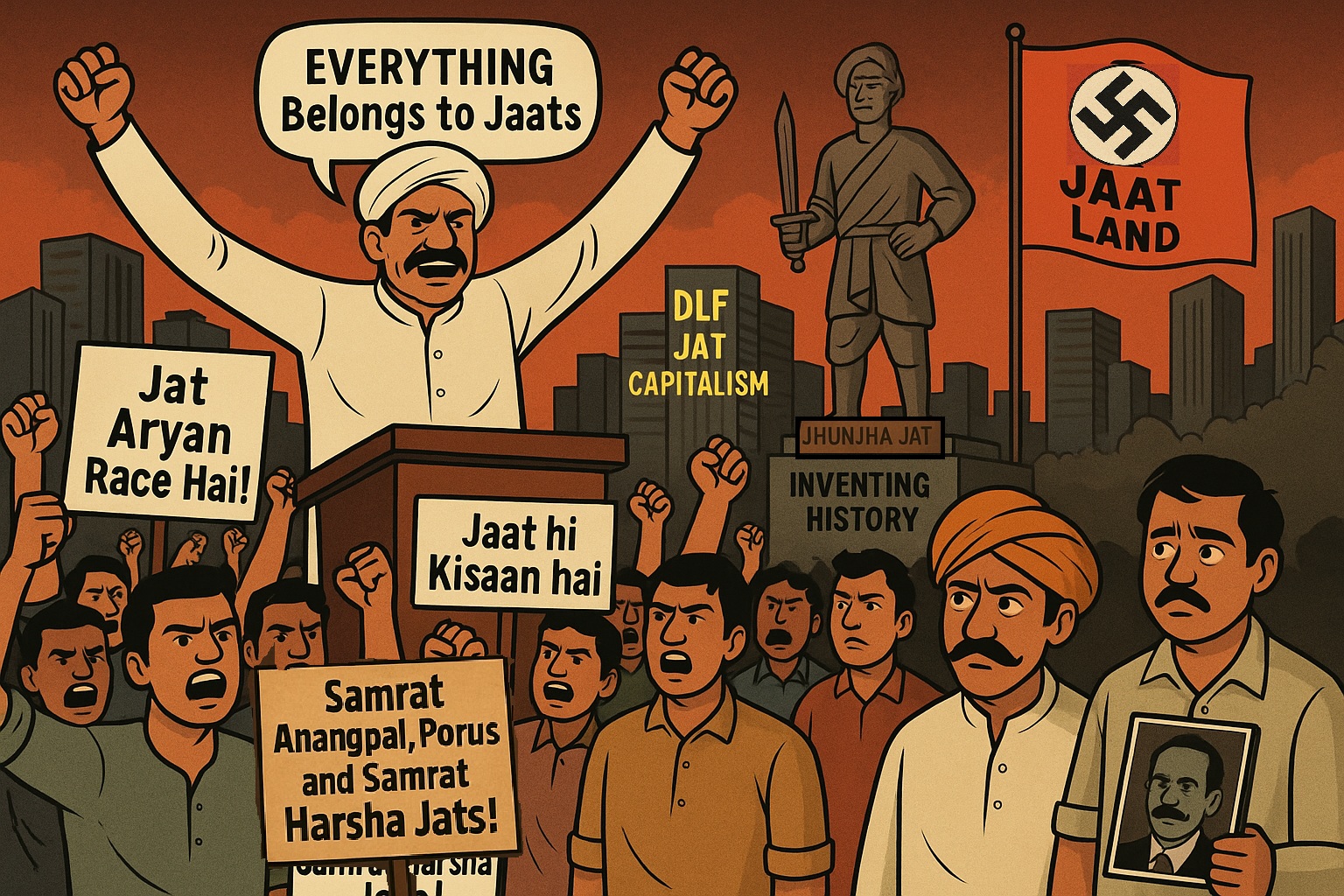Jat Politics and Nazism: A Structural and Ideological Parallel
I. Introduction: Overview of Jat History
The Jat community of Rajasthan, Haryana, and Western Uttar Pradesh largely owes its origins to pastoralist migrations from the Sindh region, particularly of camel-herding tribes, as recorded by early Arab chroniclers during the Umayyad campaigns in Sindh (8th century CE). Over time, especially after the 12th century, significant waves of these groups migrated and settled in the Punjab plains, the Bagar tract of Rajasthan, the Braj region of Western UP, and central Haryana. Initially classified as non-elite cultivators, the Jats were gradually settled under the feudal umbrella of various Kshatriya (Rajput) and later Muslim dynasties, often as peasantry or agrarian laboring castes.
Political struggles leading up to consolidation of Delhi Sultanates oversaw large-scale displacement, extermination, or political subjugation of Rajput lineages in regions such as southern Haryana and Western UP – their lands being transferred to the Jat headmen who were elevated to the position of Zamindars or Chaudharies by successive Sultanate and Mughal rulers for their loyalty. Except for isolated episodes—most prominently Gokula Jat’s rebellion in 1669—the Jats largely remained non-confrontational toward Islamic imperial authority.
In the late 19th and early 20th centuries, the Arya Samaj movement, under the leadership of Dayanand Saraswati and later Swami Shraddhanand, initiated a campaign to “Kshatriya-ize” the Jats, in an attempt to integrate them into the Brahmin-Bania political struggle to socially delegitimize the Kshatriyas or Rajputs. The Praja-Mandal movements used the language of democracy and socialism to delegitimize Rajput rule, while enabling Jat zamindars to expand their rural dominance. In states like Alwar, Bharatpur, Jaipur, and others, Rajput elites were dispossessed, discredited, and eventually replaced by Brahmin or Jat-led political apparatuses under the Congress umbrella.
Post-Independence, under Jawaharlal Nehru’s “socialist” framework, a significant economic shift took place: While these laws were presented as egalitarian, in reality, they transferred land and economic capital from Rajput landholders to dominant cultivating castes—especially Jats, making them the new economic elite—with Brahmin-Bania legal and political support.
Lohiaite Socialism, which gained dominance in the post-Mandal era, romanticized the feudalism of Jats, Gujjars, and Ahirs as symbols of an egalitarian rural society, while continuing the dismissive portrayal of Rajputs—a legacy inherited from the Arya Samaj, Praja Mandals, Congress, and the RSS. The persistent depiction of Rajasthan, Haryana and Western Uttar-Pradesh as “Jatland” by the mainstream media exemplifies this romanticization. This narrative normalized Jat rural hegemony, concealing the power networks of Jat zamindars allied with Brahmin politics and Bania capital. In contrast, it justified the political persecution and social marginalization of Rajputs, creating fertile ground for the current wave of Jat politics of hegemony.
The ideological structure of dominant Jat politics in North India—especially its rhetorical contradictions, historical revisionism, caste supremacism, and aggressive ethnic targeting— bears startling structural similarities to certain aspects of Nazi ideology and methods. Here’s a detailed comparative analysis:
1. 🔻 Socialist Rhetoric Cloaking Ethnic Supremacism
Nazism: The NSDAP (Nazi Party) called itself “National Socialist,” but this “socialism” was ethnic, not economic. It promised upliftment for “real Germans” while blaming Jews, Roma, and Slavs for Germany’s problems.
Jat Politics: Post-Lohia Jat leaders in India brandish “social justice” and “OBC upliftment,” yet in practice, this rhetoric is used to monopolize state benefits for Jats, while marginalizing Rajputs, Dalits, and non-dominant OBCs. “Samantwad” is invoked not against actual feudalism, but as an ethnic weapon to target Rajputs—even where Jats themselves have historically been the feudal power.
🔁 Parallel: Socialist language used to mobilize majoritarian caste/racial unity, while silencing or scapegoating minorities within the same society.
2. 🧬 Claims of Racial (Caste) Superiority
Nazism: Nazis claimed descent from an “Aryan master race”, glorifying their ancestry and cultural superiority to justify aggression and domination.
Jat Discourse: Jats claim to be “original Kshatriyas”, often asserting descent from Aryan tribes, even as they deny the same identity to Rajputs. This is paradoxical, as the very Rajput dynasties they vilify are historically and genealogically closer to Vedic Kshatriya clans. Jats now claim figures like Anangpal Tomar, Prithviraj Chauhan, and Harshvardhan—despite overwhelming historical evidence of Rajput origins. Read History As Social Lebensraum: Jat Disinformation On Rajput History
🔁 Parallel: Historical lies used to build ethnic or caste pride, while denouncing others as impostors.
3. 🏚 Manufactured Historical Victimhood
Nazism: Nazis thrived on the narrative that Germans were “betrayed” after WWI, and Jews were to blame for Germany’s downfall—this manufactured victimhood served to radicalize the masses.
Jat Politics: Despite being dominant landholders, sarpanchs, and political leaders in many districts, Jat leaders continuously frame the community as historically oppressed peasants—a false narrative used to justify demands for quotas, and aggressive behavior toward others.
🔁 Parallel: False historical victimhood weaponized to justify new forms of aggression and privilege.
4. 🗡 Militant Appropriation and Targeted Ethnic Hate
Nazism: Jews, Roma, and Communists were not just excluded, they were blamed, dehumanized, and finally exterminated. Hitler used national pride to justify extreme violence.
Jat Politics: Rajputs are systematically vilified—as “feudal”, “anti-Bahujan”, or “fake Kshatriyas.” Violent incidents in Dangawas, Kumher, Mirchpur, and other villages reveal the normalization of caste violence, with a sense of ethnic superiority among perpetrators and protection by Jat-dominated institutions.
🔁 Parallel: A clear strategy of scapegoating, violence, and public narrative control against identified out-groups.
5. 🗺 The “Jatland” Concept and Territorial Ethnicism (Lebensraum)
Nazism: The Nazis advanced the idea of Lebensraum (“living space”)—claiming Eastern Europe must be conquered for the Aryan race’s expansion.
Jat Politics: The idea of “Jatland” has been popularized by Jat intellectuals, student unions, and sympathetic media houses. This implies a territorial caste-ownership over entire regions of Rajasthan, Haryana, and Western UP—dismissing other castes as outsiders or historical invaders.
🔁 Parallel: Territorial domination tied to ethnic identity, leading to exclusionary political claims over shared geography.
6. 🏛 Control Over Institutions and Cultural Discourse
Nazism: Nazis purged universities, media, and civil institutions of dissent and flooded them with propaganda affirming Aryan supremacy.
Jat Strategy: In many North Indian regions, Jat elites dominate local media, panchayats, cooperatives, land tribunals, and student unions (notably in DU, Rajasthan Univ, CCSU). Cultural festivals, textbooks, and even public statues now reflect appropriated Rajput history or inflated Jat legends, sidelining both truth and historical Rajput, Dalit, and OBC diversity.
🔁 Parallel: Capture of media and cultural institutions to rewrite history and entrench dominance.
7. 🧠 Caste Purity, Endogamy, and Ethnic Policing
Nazism: Racial purity laws outlawed Jewish-German marriages and emphasized strict Aryan bloodlines.
Jat Khap System: Jats have one of the most rigid and violent caste-endogamy systems. Khap panchayats routinely issue fatwas, excommunicate, or kill (honor killings) for inter-caste marriages—especially involving Dalits, Rajputs, or even same-clan Jats.
🔁 Parallel: Obsessive control over community boundaries through purity policing and sanctioned violence.
8. Shape-Shifting Identity: Instrument Of Dominance
| Claim | Contradiction |
|---|---|
| “We are Shudra peasants” | But also “We are the Zamindars and original Aryan Kshatriyas” |
| “We hate feudalism” | But glorify our Chaudharies, Khaps, and claim Rajput dynasties |
| “We are OBC” | But resist any sub-categorization that might benefit smaller castes |
| “We fight for Bahujans” | But silence Dalit protests and block Bhim Army rallies |
This two-faced narrative becomes a tool to:
- Demand state resources and quotas
- Mobilize populist anger against Rajputs
- Legitimize their feudal hold over rural society
- Build caste pride rooted in Rajput history while excluding Rajputs themselves
II. Narrative as Weapon: How Brahmin-Bania Media Fuels Jat Fascism

In recent decades, Brahmin intelligentsia and Bania-owned media platforms have played a pivotal role in constructing and amplifying caste narratives that deliberately caricature Rajputs as feudal oppressors, while whitewashing or outright ignoring Jat dominance in civil society, local administration, and agrarian power structures. Concepts like “Thakurwad” in Uttar Pradesh and “Samantwad” in Rajasthan have been selectively deployed—not to critique actual feudalism or caste oppression—but to target the Rajput community socially, culturally, and politically, often regardless of their actual socio-economic position.
At the same time, there has been a conspicuous silence on Jat over-representation and caste-based hegemony across rural North India. This becomes starkly visible in events such as the 2013 Muzaffarnagar riots, where Jat-led khap panchayats orchestrated communal violence in villages like Kawal. Yet, dominant media narratives painted the violence as a “reaction to Rajput feudalism” or “upper-caste aggression,” despite the clear absence of Rajput involvement in the actual events.
In districts like Alwar and Bharatpur (Rajasthan)—where Rajputs now possess little administrative or economic leverage—the media still frames them as archaic relics of a bygone feudal order, while Jats, who control local institutions, are rarely scrutinized. This narrative distortion is neither accidental nor isolated—it reflects a broader ecosystem of caste-interest journalism.
Mainstream platforms like The Print (run by Shekhar Gupta) and The Quint (of Rajiv Behl) have played a central role in this distortion. These outlets routinely stereotype Rajputs as “Dalit oppressors” and feudal brutes, while they downplay or sanitize horrific atrocities committed by Jats—including the Kumher massacre (1992), Mirchpur (2010), Dangawas (2015), and Panwari (2016). In many cases, even the names of dominant-caste perpetrators are omitted, or the crimes are soft-pedaled through euphemisms like “caste tension”.
Ironically, while these media houses consistently vilify Rajputs, they often eulogize Jats, publishing inflated narratives that celebrate Jat machismo, agrarian dominance, and rural leadership. Articles referring to Rajasthan and Western UP as “Jatland” not only legitimize caste hegemony but romanticize it—recasting domination as cultural pride and resistance.
This skewed narrative ecosystem—driven by Brahmin-Bania editorial control—acts in tacit alliance with Jat caste politics, ensuring that Jat Fascism is not only normalized but celebrated, while the Rajput community is scapegoated as a feudal remnant, regardless of its actual conditions. As Human Rights Watch and Indian Express have reported, legal and media accountability for Jat-led violence remains minimal, further exposing the caste-selective ethics of India’s mainstream discourse.
⚠️ Conclusion: When Dominant Castes Mimic Fascist Ideology
While the socio-historical contexts of Germany and India are distinct, the ideological mechanisms of Jat caste supremacy and Nazism share disturbing similarities:
-
Mythologized ancestry
-
Fabricated grievances
-
Ethnic hatred
-
Historical distortion
-
Cultural appropriation
-
Territorial supremacy
-
Violent enforcement of social hierarchy
This is not to equate Jat identity with Nazism, but to highlight the structural dangers of caste politics that relies on lies, hate, and control—especially when cloaked in progressive slogans like socialism or backward-class justice.
Unless such narrative authoritarianism is exposed, India’s democracy risks being reshaped not by constitutional ideals, but by caste supremacists who wear the mask of the oppressed while building empires of exclusion.

